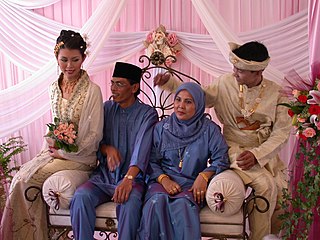Related Research Articles
The Malay language has a complex system of styles, titles and honorifics which are used extensively in Brunei Darussalam, Malaysia and Singapore.

Malay Singaporeans are Singaporeans of Malay ancestry, including those from the Malay Archipelago. They constitute approximately 13.5% of the country's residents, making them the second largest ethnic group in Singapore. Under the Constitution of Singapore, they are recognised by the government as the indigenous people of the country, with Malay as the national language of Singapore.

Sultan of Selangor is the title of the constitutional ruler of Selangor, Malaysia who is the head of state and head of the Islamic religion in Selangor. The current monarch, Sultan Sharafuddin Idris Shah ascended the throne on the death of his father, on 22 November 2001.
This article lists important figures and events in Malaysian public affairs during the year 1992, together with births and deaths of notable Malaysians.

This article lists important figures and events in Malaysian public affairs during the year 1991, together with births and deaths of notable Malaysians.

Sultan Alam Shah Museum is a museum in Shah Alam, Petaling, Selangor, Malaysia. It is the state museum of Selangor. This museum was opened in 1989 by Sultan Salahuddin Abdul Aziz Shah.

The Kingdom of Luwu was a polity located in the northern part of the modern-day South Sulawesi province of Indonesia, on the island of Sulawesi. It is considered one of the earliest known Buginese kingdoms in Sulawesi, founded between the 10th and 14th century. However, recent archaeological research has challenged this idea.

Malay Indonesians are ethnic Malays living throughout Indonesia. They are one of the indigenous peoples of the country. Indonesian, the national language of Indonesia, is a standardized form of Riau Malay. There were numerous kingdoms associated with the Indonesian Malays along with other ethnicities in what is now Indonesia, mainly on the islands of Borneo and Sumatra. These included Srivijaya, the Melayu Kingdom, Dharmasraya, the Sultanate of Deli, the Sultanate of Siak Sri Indrapura, the Riau-Lingga Sultanate, the Sultanate of Bulungan, Pontianak Sultanate, and the Sultanate of Sambas. The 2010 census states that there are 8 million Malays in Indonesia; this number comes from the classification of Malays in East Sumatra and the coast of Kalimantan which is recognized by the Indonesian government. This classification is different from the Malaysia and Singapore census which includes all ethnic Muslims from the Indonesian archipelago as Malays.
Daeng Parani was one of the five Bugis brothers from Luwu, Sulawesi, who established political dominance over the royal houses of Peninsular Malaysia. Daing Parani became personally embroiled in the politics of the Sultanates of Johor, Riau, Lingga and Pahang in the early 18th century.

The Indonesian Malaysians are Malaysian citizens of Indonesian ancestry. Today, there are many Malaysian Malays who have lineage from the Indonesian archipelago and have played an important role in the history and contributed to the development of Malaysia, they have been assimilated with other Malay communities and are grouped as part of the foreign Malays or anak dagang in terms of race. The Malaysian census does not categorize ethnic groups from the Indonesian archipelago as a separate ethnic group, but rather as Malay or Bumiputera.
The Selangor royal family consists of the family members of the sultan of Selangor. It currently consists of Sharafuddin of Selangor and his close relations.
Raja Kecil, or Raja Kecik, also known as Sultan Abdul Jalil Rahmat Shah, was the first sultan of the Sultanate of Siak Sri Indrapura. A controversial figure, due to his origin tales and the rebellion he led, Raja Kecil united a multi-ethnic force in eastern Sumatra to defeat the Johor Sultanate in 1718. He then ruled Johor for four years, before retreating to eastern Sumatra, where he established a new state along the Siak River in 1722. The rulership of Johor was then passed to Sultan Sulaiman under the heavy dominance of the Bugis elites headed by, among others, Daeng Marewa.

The Minangkabau Malaysians are citizens of the Malaysia whose ancestral roots are from Minangkabau of central Sumatra. This includes people born in the Malaysia who are of Minangkabau origin as well as Minangkabau who have migrated to Malaysia. Today, Minangkabau comprise about 989,000 people in Malaysia, and Malaysian law considers most of them to be Malays. They are majority in urban areas, which has traditionally had the highest education and a strong entrepreneurial spirit. The history of the Minangkabau migration to Malay peninsula has been recorded to have lasted a very long time. When the means of transportation were still using the ships by down the rivers and crossing the strait, many Minang people migrated to various regions such as Negeri Sembilan, Malacca, Penang, Kedah, Perak, and Pahang. Some scholars noted that the arrival of the Minangkabau to the Malay Peninsula occurred in the 12th century. This ethnic group moved in to peninsula at the height of the Sultanate of Malacca, and maintains the Adat Perpatih of matrilineal kinships system in Negeri Sembilan and north Malacca.
The Bugis-Malay, also known as Buginese-Malay, Malay-Bugis, Melayu-Bugis or Peranakan Bugis, are a cultural and ethnic group with heritage rooted in both Malay and Bugis communities, typically comprising individuals of mixed Malay and South Sulawesi ancestry. This group descends from multiple waves of migration from South Sulawesi, particularly to Johor and Riau Archipelago, as well as Selangor, Singapore and other areas, between the 17th and early 20th centuries.
References
- ↑ Loveard, Dewi (1999-06-25). "Target: The Attorney General Andi Ghalib is himself the subject of a probe". Asiaweek . Retrieved 2016-06-07.